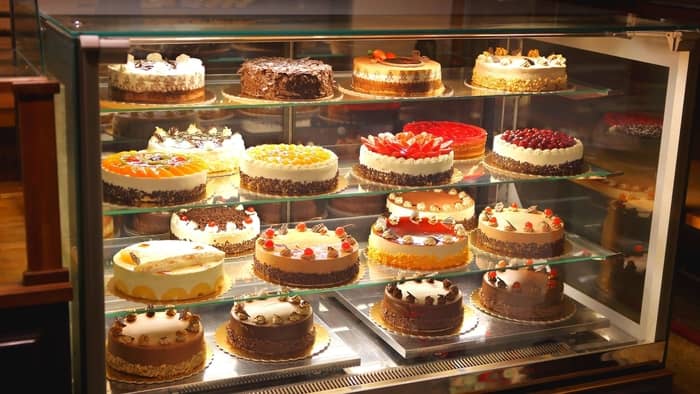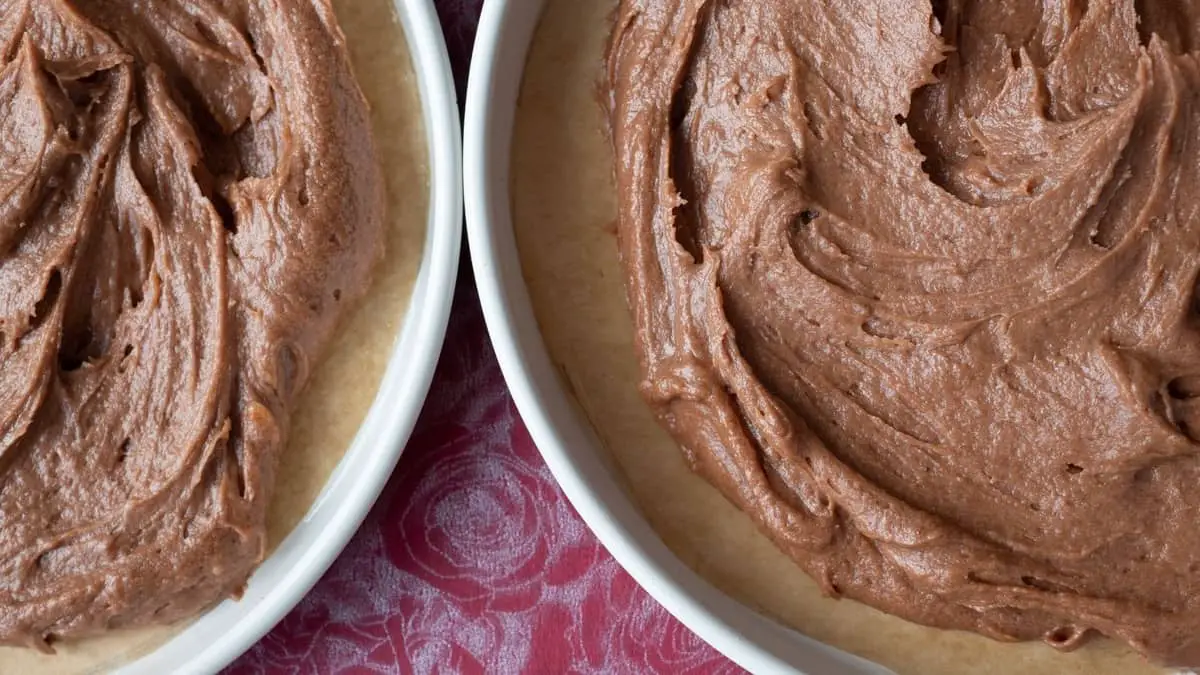Last Updated on March 20, 2022
Are you wondering what the correct cake batter consistency is? Or how to fix a clearly faulty batter? Today, we answer these questions and more!
We will have a look at the 3 main types of cake batters you get and some common cakes using these consistencies. And, we have even included some techniques to try for faulty consistencies, like too runny or thick batters.
What Exactly Is A Cake Batter?
A basic cake batter is made from a combination of butter, sugar, eggs, flour, and raising agents. They also often include flavoring ingredients like juices, extracts, or syrups. This batter is then poured into a cake pan and baked to make various shapes and sizes of cakes.
Naturally, there are hundreds, if not thousands of different types of cakes. What mainly affects the type of cake you are making is the ingredients used, which directly affects the cake batter consistency.
While there are many other factors that have an effect on the texture of a baked cake (such as leavening agents used and texture of the batter), the cake batter consistency is a big contributing factor too.
How does batter consistency affect the texture of a baked cake?
Batter consistency is really important when it comes to the texture of the cake! If it is too runny it will often produce a very dense cake with no volume at all. This can potentially create a putty-like texture that is tough and dry.
However, batters that are too thick can also create dense and dry cake textures.
So, the key is finding the right balance of wet and dry ingredients. Once you get the right consistency, it will massively help you get the right cake texture.
What Are The 3 Main Cake Batter Consistencies For Different Types Of Cakes?
First, it is important to know that batter consistency and batter texture are two different things. The texture of a batter will affect, for example, the softness of the cake (the airiness). The consistency of the batter mainly affects how dry (or moist) and to a certain extent, dense a cake will be.
So, we have provided you with a guide on 3 main consistencies for cake batters. And, we have included some common types of cakes that are often made with these consistencies.
If you are unsure why your cake came out faulty, you can also have a look at some common cake baking problems. Often, the consistency of your batter is at fault!
1. Cakes that require a thick cake batter consistency
These cakes should have a batter consistency that almost plops off of a spoon. It isn’t runny at all, but the batter can still move. When you add a dollop of batter onto the rest, it doesn’t merge with the rest.
Carrot cake
Carrot cake usually has a thick cake batter consistency because of the grated carrots used in the mixture! But, the oil that most recipes contain does make the batter pliable. And of course, don’t worry about the lumpiness of the carrots in the batter itself- it is meant to have that batter texture.
Poundcake
Pound cakes, also known as butter cakes, have a very thick consistency. This is mostly because it uses equal amounts of butter, eggs, flour, and sugar. These cakes are generally aerated by creaming the sugar and eggs together. But, the leavening effect still only happens once the cake is baked.
Red velvet cake
This cake has a tender texture thanks to the high amount of fat incorporated into the sponge batter. It is made using a creaming method, which leaves it with a thick batter. The final texture of the cake is still quite light thanks to the bicarb used.
2. Cakes that have a medium cake batter consistency
These are arguably the thinnest a cake batters’ consistency will be. These batters easily merge with each other and don’t hold any shape. But, they are still thicker than a pancake batter so that it can still support the height of the cake layer.
Cheesecake
Cheesecake is basically a baked custard, which is why the consistency isn’t very thick. It has little or no flour in the recipe, so the ingredients don’t become thick at any time.
The actual consistency of the batter is adjusted with other liquid ingredients, like milk or cream. They essentially thin the beaten cream cheese.
And, for some types of cheesecakes, whipped egg whites are folded in to give the batter an aerated and lighter consistency. While it can still be thick, it is the texture of the batter that differs.
Chocolate cake
An all-time favorite! Chocolate cakes often contains a lot of oil which creates a thinner batter. But, because the recipes still contains a lot of flour, they are often thicker than pancake batter.

3. Cakes that require an aerated batter
These batters have more to do with the texture than the actual consistency. Aerated batters are very light and often create soft cake textures. But, the consistency of the aerated batter itself can still be thick or thin.
Japanese cheesecake
Japanese cheesecake has a similar texture of a souffle. Beaten eggs whites are gently folded into the batter which makes it light and aerated. But, generally, the batter isn’t very runny and will still hold its shape.
Angel food cake
Angel food cake is another cake that is made using whipped egg whites. Again, they give the batter a light and airy texture. The consistency of these batters is runnier.
How To Adjust The Consistency Of Your Cake Batter
If you notice that your cake batter is way off from what it should be, you can try and save it. However, making too big adjustments can also completely ruin your cake, so just be realistic.
How to fix a thick cake batter consistency
For cake batters that are too thick, try adding a little bit of warm water to the batter. Melted butter or milk can also do the trick! Always use a liquid that is already present in the recipe.
Remember to add a bit of liquid at a time. Adding too much will make the batter too runny, which is very hard to fix.
And, also try to prevent overworking the batter. This can also ruin the cake texture.
Fixing too runny cake batter consistency
Simply add a little bit of the flour to the batter. Almond flour or coconut flour can be used as substitutes if necessary.
Also, remember to add sifted flour and whisk the mixture well to prevent any lumps from forming.
Final Thoughts
You shouldn’t have to worry about cake batter consistency when making delicious treats. Hopefully, our in-depth article have taken some of the load off! But, if you still have any questions for us, please don’t hesitate to ask us in the comments below!
FAQs
Is cake batter supposed to be thick?
It depends entirely on the type of cake batter you are making. And, even then the exact thickness of a thick batter will still vary between different types. Thick cake batters are usually more denser cakes, like pound cakes or cheesecakes. These cakes, while they can be soft, are not extremely aerated or fluffy.
How do you know when cake batter is ready?
If you are looking for a medium (or thin) cake batter, the consistency is right when a dollop placed on top fully merges with the rest of the batter. A thick cake batter shouldn't merge quickly or at all. And, only mix ingredients together until they are just combined. Over mixing does thin a batter and causes loads of problems.
What consistency should cake batter be?
There isn't one correct consistency for cake batters. It depends entirely on the type of cake you are making. If you are making a carrot cake, the consistency will be very thick. But, if you are making an Angel food cake, the consistency is airy and more runny.
What is the right consistency for chocolate cake batter?
Chocolate cake batter should have a runnier consistency because of the oil added. If the consistency is too thick, the cake will be incredibly dry because of the cocoa powder added.

Lindy Van Schalkwyk is a culinary specialist with a background in Advanced Cooking, Advanced Pâtisserie, Media Communications and Nutrition. She has gained invaluable experience in the culinary industry having worked in some of the top restaurants in Africa in 2016 and 2017. Her expertise in nutrition has enabled her to develop recipes for special dietary needs. In 2018, Lindy began working in the Food Media industry, focusing on recipe development, recipe writing, food writing and food styling.


